
Yu-Gi-Oh: 10 Most Powerful Unbanned Cards In The Game
The damage has been done - These cards need to get banned!
The first-ever ban list dropped six months after the release of Invasion of Chaos all the way back in 2003. Up until that point, Konami had a select few cards in the firing line but the introduction of the legendary Chaos Emporer Dragon and its interact with Yata-Garasu literally stopped your opponent from drawing cards and playing the game and called for immediate attention.
Flash forward 17 years and the ban list has become a mainstay of current YuGiOh. Every three months Konami introduces a new ban list where cards are banned, unbanned or limited.
The intention is to make the game fun, diverse and balanced, there are over 10,000 YuGiOh cards, one of these is bound to work unfavourably with another at some point and this is when Konami step in.
The cards on today's list have come under fire for various reasons such as monoternous and repeativie play patterns, for being too expensive, for not allowing your opponent to play, for causing 20 minute turns and for simply being unfun and unfair to play with and against. The cards on today's list need addressing one way or another
10. Aleister The Invoker
Aleister The Invoker and the Invoked engine has been a meta mainstay since its release all the way back in 2017s Fusion Enforcers.
Aleister is a spellcaster obsessed with fusing his body with the elements via sacred magic. In the deck Aleister the glue that holds the core together and allows for the core to be combined with a wide variety of other archetypes.
Aleister is your main normal summon, a level four monster that allows you to search out Invocation, the decks busted fusion spell. One of the reasons he's so good is card economy as he instantly replaces himself with a key spell card on summon.
Using Aleister and Invocation you have a swiss army knife of powerful fusion monsters at your disposal. The line of play is often the same, Aleister will get Invocation, you'll fuse Aleister away alongside one of your or your opponents monsters (Invocation allows you to use your opponent's monsters as material if in the graveyard) and you'll return Invocation back to the deck to return Aleister back to your hand ready for his second ability.
His second ability is just icing on the cake allowing you to discard Aleister from your hand to increase the attack of one of your fusion monsters by 1000. When combined with Invoked Purgotrio is can the difference between winning and losing and the fact that you can add Aleister back to your hand from your graveyard via the ability of Invocation makes for ''naturally easy plays''.
The engine melds well with other archetypes and since its release its seen tournament success with Mekk-Knights, Blue-Eyes and most recently with Shaddolls.
It's worthy of a ban because its had its day in the sun and people are sick to death of the common play patterns over and over. When added to other archetypes it dilutes the duelist's creativity as it quickly locks up extra deck space (you only have 15 slots and over half will be taken up with Invoked fusion monsters) and main deck space, you need the main man himself, the field spell, Invocation etc.
Aleister was limited to one in the OCG and parts of the deck has been limited in the TCG so Konami definitely has their eye on the core.
9. Evenly Matched
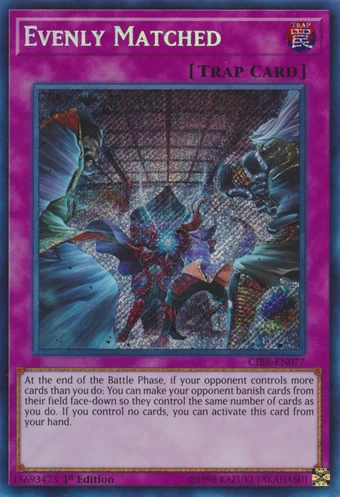
Released in 2017s Circuit Break as a secret rare Evenly Matched is a trap card unlike any other. It forces your opponent to banish (the term for removing a card from the game) face down all cards they control until both players control the same amount of cards.
The unfair part of Evenly is it can be played directly from the hand if you control no cards. The typical play patters was to allow your opponent to go first and establish a field of monsters and then in your turn drop Evenly and make them banish all but one.
One of the fairer parts of Evenly Matched is even if I play it from my hand and control no other cards upon activation it counts as one card, so if my opponent has four cards and I activate Evenly Matched they'll be forced to banish three cards. It also has to be played at the end of the battle phase which meant if you wanted to play it from your hand you're forced to give up your battle phase.
A problem with Evenly Matched was not just the £60 price tag and the fact that you needed three of them, it was the fact that it went in every competitive deck. It severely stifled deck creativity, especially in the side deck. Didn't know what to include in your side deck for a particular match up? Just jam three copies of Evenly.
Another major problem was the decks it was good against, such as Altergiest and True Draco couldn't stop it, it acted like an alternative win condition against certain decks that couldn't be stopped, it involved zero skill to play and couldn't be played around.
8. Ash Blossom & Joyous Spring
Ash Blossom & Joyous Spring is commonly referred to as a 'handtrap'. As YuGiOh evolved there was a time where traps became far too slow, having to set a card and wait till the next turn was not worth it.
Ash Blossom is a level 3 monster with 0 attack and 1800 defence but the stats are largely irrelevant, the card has seen a monumental amount of play based on its effects. It has three effects, one of which can be used each turn by specifically discarding it from your hand. It stops cards being added to your hand, this includes drawing cards outside of your draw phase. It stops you sending a monster from your deck to your graveyard - most decks do this, and lastly, it stops a monster from being special summoned directly from the deck.
So in the current metagame it stops Pot of Desires, Dragon Shrine, Card of Demise, or any monster that has a search effect when you play it. The list goes on and on. There was a point in time when Ash Blossom commanded a massive £100 price tag, and you definitely needed three for your deck.
In fact, when it was printed back in Maximum Crisis it was the death of certain decks at the time, specifically the world championship-winning Blue-Eyes deck. Ash has been semi-limited to two in the OCG but nowadays Ash can be found everywhere across various rarities meaning the average price is around £8.
The chance of a ban or limit is highly unlikely but there was a time when duelist wanted it gone because of how versatile and how expensive it was.
7. True King Of All Calamities


Dark Ruler No More is the opposite to True King Of All Calamities but its a spell card that negates all face-up monster effects for the rest of the turn.
The real killer is your opponent can't respond to the activation of this card. This means they can't negate it or chain with a trap or monster effect. Granted no battle damage is done during the turn Dark Ruler No More is activated but you can still attack and destroy your opponent's monsters.
What cards like True King and Dark Ruler No More promote is zero interaction and little reward for playing your deck to its strengths. Player one goes through their deck and sets up a board full of monsters - this does take skill in memorizing your deck's combos with various cards - but all it takes is one card from your opponent to completely decimate their board and make everything they did a waste of time.
Cards that prohibit your opponent from responding to are very powerful and extremely unfair - imagine something similar in any other game, an item or gun your opponent just couldn't stop you from using but always resulted in a head-shot!
When your opponent's monsters have no effects it takes little to no skill in mopping the floor with your opponent's entire board and makes taking the win all the easier.
5. Super Polymerization
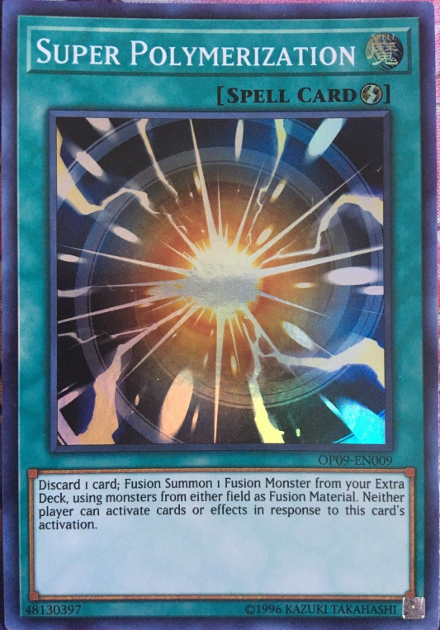
Super polymerization is like the original Polymerization on super steroids.
By discarding one card Super Poly allows you to fusion summon a monster from your extra deck using monsters from EITHER side of the field! So you can't use materials from your hand but you can use monsters your opponent controls.
This means if you know the metagame well you can kit out your extra deck to combat any monsters your opponents could play or counter any board they may make.
The real strength in Super Poly is it can be played at quick-play speed at the end of your opponents turn AND your opponent can't respond to its activation.
Similar to Dark Ruler No More once activated that's it, no chance to respond or chain a monster effect. This means your opponent just has to watch as you use their monsters as material for one of your fusion monster (that's likely catered to beating there deck).
The argument against Super Poly is how it's a no skill card that punishes people for playing their deck to the best of their ability. Duelist A spends all day memorising the combos of their deck and should be rewarded, duelist B simply plays Super Poly and there goes all their hard work. The reason for banning it is its very hard to play around, promots little interaction and is super punishing to new or returning players.
4. Jet Synchron
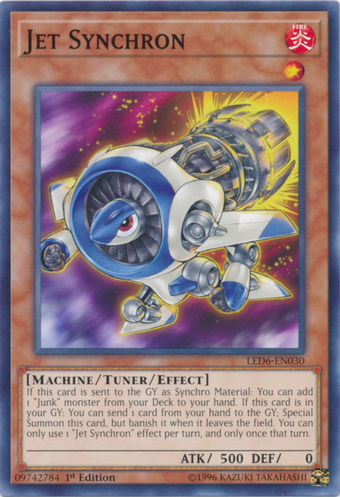
Jet Synchron is a level 1 tuner monster with 500 attack and 0 defence that allows you to discard one card from your hand to return it from your graveyard to play. The common play is to synchro him away and revive him using its effect ready for another summon.
The real problem with this card is since Crystron Halqifibrax became legal it's super easy to abuse and combo off with Jet Synchron and make unbreakable boards, first turn kills or essentially make it so your opponent can't play.
Jet Synchron promotes this unhealthy, solitaire style of YuGiOh play where you can play through any hand trap or form of interaction your opponent may have and allows you to do what you want in terms of special summoning monsters your deck normally wouldn't be able to have access to. 100% should be on the ban list.
3. Mystic Mine
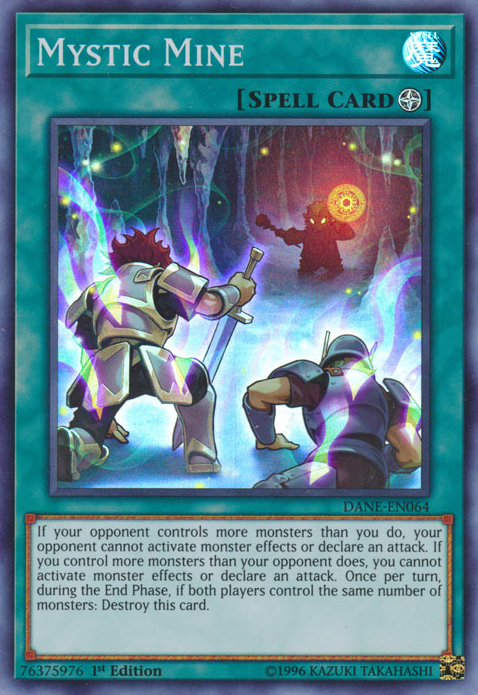
Mystic Mine is a field spell that soft locks the game. If your opponent controls more monsters than you do, your opponent cannot activate monster effects or declare an attack.
The effect works both ways as if you control more monsters than your opponent you cannot activate effects or declare attacks but this diminishing effect never affects the player controlling Mystic Mine. If both players control the same amount of monsters Mystic Mine is destroyed.
Mystic Mine is currently at three in the TCG but players have been complaining about the card for the last year. The main argument is the game is extremely boring to play against and shuts down every effect monster in the game. Mystic Mine isn't that easy to destroy as most monsters have built-in destruction effects but if Mystic Mine is already on the field they cant be used.
Additionally, spell and trap removal is at an all-time low at the moment and Mystic Mine decks are usually backed up with trap cards that can negate anything, such as Solemn Judgment. The biggest argument against Mystic Mine is the player using it gets all the control, the common scenario is the opponent stops playing monsters until they draw their spell removal but this could take some time, all the while the player with Mystic Mine is building up their resources until the time they want to remove it and win the game. The card just stops the game in its tracks and gives a huge advantage to the duelist playing it, if everyone played it games would never finish!
The TCG has lived with Mystic Mine for just over a year now and everyone is surprised its lasted this long. Don't be surprised if the card is limited to one on the next Forbidden and Limited list.
2. Cryston Halqifibrax
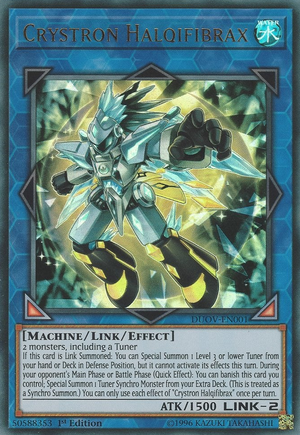
The card that took nearly three years to come to the TCG and current YuGiOh players have a love/hate relationship with. Crystron Halqifibrax is a link monster that promotes synchro summoning, which is very cool, and its second ability allows you to 'tag' him out for a synchro monster from your extra deck - again a very cool and unique ability.
It's the second ability that is absolutely not fair and is currently causing the YuGiOh world a bunch of problems. When Halqifibrax is summoned he allows you to search your deck and special summon one tuner monster directly to the field.
In conjunction with our last entry, Jet Synchron and Mecha Phantom Beast O-lion its giving duelist access to monsters they normally wouldn't include in their deck or extra deck and in turn are allowing for first-turn kills, combos such as ripping every card from your opponent's hand or forcing you to watch as they 'play with themselves' for 15 minutes summoning over and over again until they have a board full of powerful monsters that essentially stop you from playing.
For the readers who know current YuGiOh they know what we mean when we say Haliqifibrax will only get more busted with the printing of either new level 3 or lower tuner monsters or monsters that generate tokens such as Linkcross. Halqifibrax is responsible for numerous 1 card combos that wreck the game, its clear Konami was hesitant to bring the card to the TCG and its now obvious to see why.
1. Linkcross

Linkcross is the most recent card on the list, debuting in 2020s Eternity Code. Linkcross is a level 1 link monster but you need to Tribute a level 2 or higher link monster in order to summon it.
Upon summon Linkcross special summons 'link tokens' equal to the link rating of the monster used to originally summon Linkcross, the typical number being 2, to your side of the field. While the tokens cant be used to link summon they can be used to synchro summon other monsters, most notably Martial Metal Marcher being the main culprit.
In the short time it's been legal this interaction has allowed players to access extra deck monsters their deck normally wouldn't have access to and has caused a number of first turn kills or combos that involve stripping your opponents of all their cards in their hand.
Linkcross should just be straight out banned as it only gets stronger with the printing of new synchro monsters with similar effects as Metal Marcher or link monsters with a link rating of two or higher that are easily summoned.
In the OCG Linkcross was instantly limited to one and was recently banned on their latest Forbidden and Limited list. This is a strong sign that the same will follow in the TCG.
Source: whatculture.com
Leave a comment